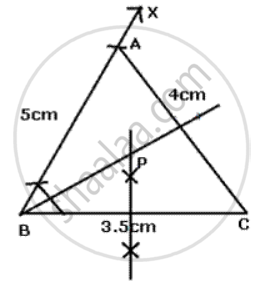Advertisements
Advertisements
प्रश्न
Using only ruler and compasses, construct a triangle ABC 1 with AB = 5 cm, BC = 3.5 cm and AC= 4 cm. Mark a point P, which is equidistant from AB, BC and also from Band C. Measure the length of PB.
उत्तर

Steps of construction:
(i) Draw a line segment BC = 3. 5 cm.
(ii) With Bas centre and radius 5 cm draw an arc.
(iii) With C as centre and radius 4 cm draw another arc which intersects the first arc at A.
(iv) Join AB and AC.
(v) Dr aw perpendi cu I ar bi sector of BC.
(vi) Dr aw the angle bi sector of angle ABC which intersects the perpendicular bisector of BC at P.
Pis the required point which is equidistant from AB, BC, Band C.
The length of PB = 2.5 cm
APPEARS IN
संबंधित प्रश्न
O is a fixed point. Point P moves along a fixed line AB. Q is a point on OP produced such that OP = PQ. Prove that the locus of point Q is a line parallel to AB.
AB and CD are two intersecting lines. Find a point equidistant from AB and CD, and also at a distance of 1.8 cm from another given line EF.
Construct a rhombus ABCD whose diagonals AC and BD are 8 cm and 6 cm respectively. Find by construction a point P equidistant from AB and AD and also from C and D.
In Δ PQR, s is a point on PR such that ∠ PQS = ∠ RQS . Prove thats is equidistant from PQ and QR.
Describe completely the locus of points in the following cases:
Centre of a circle of varying radius and touching the two arms of ∠ ABC.
Describe completely the locus of points in the following cases:
Centre of a cirde of radius 2 cm and touching a fixed circle of radius 3 cm with centre O.
Construct a triangle BPC given BC = 5 cm, BP = 4 cm and .
i) complete the rectangle ABCD such that:
a) P is equidistant from AB and BCV
b) P is equidistant from C and D.
ii) Measure and record the length of AB.
State and draw the locus of a point equidistant from two given parallel lines.
Without using set squares or protractor construct:
(i) Triangle ABC, in which AB = 5.5 cm, BC = 3.2 cm and CA = 4.8 cm.
(ii) Draw the locus of a point which moves so that it is always 2.5 cm from B.
(iii) Draw the locus of a point which moves so that it is equidistant from the sides BC and CA.
(iv) Mark the point of intersection of the loci with the letter P and measure PC.
How will you find a point equidistant from three given points A, B, C which are not in the same straight line?
